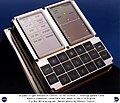File:Apollo display and keyboard unit (DSKY) used on F-8 DFBW DVIDS683588.jpg
Appearance

Size of this preview: 765 × 600 pixels. Other resolutions: 306 × 240 pixels | 612 × 480 pixels | 980 × 768 pixels | 1,280 × 1,004 pixels | 2,560 × 2,007 pixels | 3,030 × 2,376 pixels.
Original file (3,030 × 2,376 pixels, file size: 6.18 MB, MIME type: image/jpeg)
File history
Click on a date/time to view the file as it appeared at that time.
| Date/Time | Thumbnail | Dimensions | User | Comment | |
|---|---|---|---|---|---|
| current | 06:29, 9 October 2021 |  | 3,030 × 2,376 (6.18 MB) | Huntster | Cropped 9 % vertically using CropTool with lossless mode. |
| 06:28, 9 October 2021 |  | 3,030 × 2,606 (5.97 MB) | Huntster | Full resolution from NASA. | |
| 00:42, 6 May 2015 |  | 1,536 × 1,321 (303 KB) | Fæ | == {{int:filedesc}} == {{milim | description = {{en|1=The display and keyboard (DSKY) unit used on the F-8 Digital Fly-By-Wire (DFBW) aircraft during Phase I of the fly-by-wire program. Warning lights are in the upper left section, displays in the uppe... |
File usage
The following 2 pages use this file:
Global file usage
The following other wikis use this file:
- Usage on ar.wikipedia.org
- Usage on es.wikipedia.org
- Usage on fi.wikipedia.org
- Usage on fr.wikipedia.org
- Usage on he.wikipedia.org
- Usage on hu.wikipedia.org
- Usage on ja.wikipedia.org
- Usage on pl.wikipedia.org
- Usage on ru.wikipedia.org
- Usage on uk.wikipedia.org


